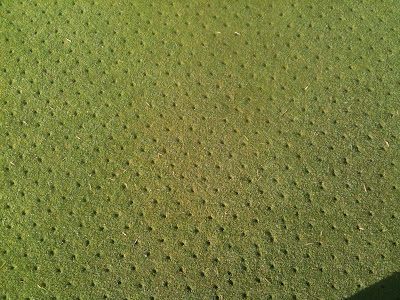I seem to have caught a few of the members off guard this year with my late fall greens aeration. This is something that I have done for the past 3 years on our putting greens. It usually goes unnoticed as the weather is usually terrible in November. This year I did it on November 14.
I punch the greens in the late fall and sometimes in the late winter with 3" long 3/8" diameter solid tines. These tines don't take a core out like we do every spring and fall.
There are two reasons I aerate this time of year. The first is to increase drainage on the greens to help keep them as dry as possible. We often see large volumes of rain and puddling is a concern as well as ice if it gets cold out. Last night the course received about 1" of rain and there wasn't a single puddle on any of our putting greens! Ideally we would aerate deeper but our current equipment only allows us to punch holes 3" deep.
The second reason I aerate in the late fall is to help increase the soil-air gas exchange. With all the rain in the winters our soils often become anaerobic and black-layer can become a problem. The aeration helps open up the soil and allows the it to "breathe". The disruption to play is usually minimal and the holes should be more or less covered by the end of the week. The pay-off from this process is a healthier plant and better playing conditions in the spring!
I punch the greens in the late fall and sometimes in the late winter with 3" long 3/8" diameter solid tines. These tines don't take a core out like we do every spring and fall.
There are two reasons I aerate this time of year. The first is to increase drainage on the greens to help keep them as dry as possible. We often see large volumes of rain and puddling is a concern as well as ice if it gets cold out. Last night the course received about 1" of rain and there wasn't a single puddle on any of our putting greens! Ideally we would aerate deeper but our current equipment only allows us to punch holes 3" deep.
The second reason I aerate in the late fall is to help increase the soil-air gas exchange. With all the rain in the winters our soils often become anaerobic and black-layer can become a problem. The aeration helps open up the soil and allows the it to "breathe". The disruption to play is usually minimal and the holes should be more or less covered by the end of the week. The pay-off from this process is a healthier plant and better playing conditions in the spring!
